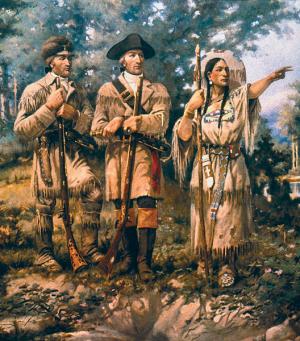Sacagawea

The multilingual Sacagawea accompanied the Corps of Discovery Expedition with Lewis and Clark from 1805-1806. They traveled from the Northern plains to the Rocky Mountains to the Pacific Ocean and back. Her skills as a navigator and translator were invaluable. Her presence calmed other Native tribes who might otherwise have been hostile toward the expedition team. Remarkably, Sacagawea faced all the challenges and difficulties the men on the journey faced, all while caring for her son she birthed just two months prior to embarking on her amazing journey with the Lewis and Clark Expedition.
What examples can we draw from Sacagawea? In this lesson, students will learn about Sacagawea and her contributions to the Corps of Discovery and the Lewis and Clark Expedition. While exploring her life and her contributions to the Lewis and Clark Expedition, students will mind map key details.
One 45-60 minute class period
Students will…
- read and understand a historical biography about Sacagawea.
- make connections to Sacagawea’s contributions to territorial expansion
- write in response to reading.
- learn the art of creative mind mapping
- create a mind map of Sacagawea’s life and accomplishments
Students should have a basic understanding of the Louisiana Purchase and the Lewis and Clark Expedition.
- 1 sheet of legal paper per student
- fine tip colored markers and colored pencils
- Sacagawea by Lise Erdich
- Lesson Plan pdf
Before starting, read the Biography
- Hand out “Mind Mapping: A Guide for Students” (pg 4) and discuss how a mind map is like a map.
- Ask students the following questions:
- Who was Sacagawea?
- What is she known for?
- Why do you think a mind map might be an appropriate tool to “map” Sacagawea’s life story?
- Show a video that demonstrates mind mapping. https://www.youtube.com/watch?v=wLWV0XN7K1g
- Pass out an 11” X 17” sheet of legal paper and fine tipped markers and colored pencils to each student. (Markers and colored pencils can be shared in groups of 4-6.)
- Explain that you will be reading a biography about Sacagawea and as you read, you would like students to mind map the key details of Sacagawea’s life and accomplishments. Students will begin by drawing a picture to represent Sacagawea in the center of their paper. Next, they will make six to ten main branches stemming from their center drawing for the main ideas they want to map. If this is the first time mind mapping, you may want to guide them in selecting main ideas as you are reading.
- Read aloud Sacagawea by Lise Erdich and ask students to mind map main ideas and details as you are reading.
- After reading, give students additional time to finish mind maps. Encourage them to draw pictures and use color.
- Share unfinished mind maps
Ask students:
- What were the main ideas you selected from the reading? Why?
- How did you represent that on your Mind Map?
- What do you think is the most important reason to study Sacajawea?
Students can use additional resources such as other books or the internet to add to their mind maps at home.
In accessing the Mind maps, focus on both creativity and accuracy in relating information.
- Extend the discussion by assigning students to do a more in-depth research on the roles of women in the Hidatsa and Shoshone Indian tribes.
- Students can learn more about Meriwether Lewis and Roger Clark by reading How We Crossed the West: The Adventures of Lewis and Clark by Rosalyn Schanzer or doing research on the internet.
NCSS-USH.5-12.4 ERA 4: Expansion and Reform (1801-1861)
- Understands United States territorial expansion between 1801 and 1861, and how it affected relations with external powers and Native Americans
- Understands how the industrial revolution, increasing immigration, the rapid expansion of slavery, and the westward movement changed the lives of Americans and led toward regional tensions
- CCSS.ELA-Literacy.RH.11-12.2 Determine the central ideas or information of a primary or secondary source; provide an accurate summary that makes clear the relationships among the key details and ideas.
- CCSS.ELA-Literacy.RST.6-8.2 Determine the central ideas or conclusions of a text; provide an accurate summary of the text distinct from prior knowledge or opinions
- CCSS.ELA-LITERACY.WHST.6-8.1.A
Introduce claim(s) about a topic or issue, acknowledge and distinguish the claim(s) from alternate or opposing claims, and organize the reasons and evidence logically. - CCSS.ELA-LITERACY.RH.9-10.5
Analyze how a text uses structure to emphasize key points or advance an explanation or analysis.
